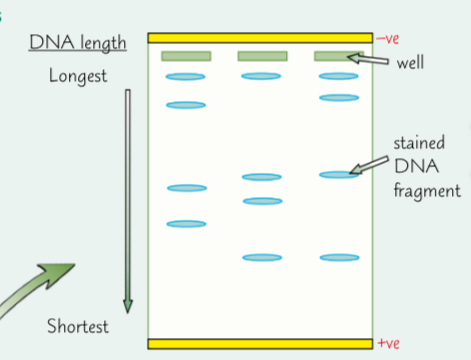DNA profiling
1/27
There's no tags or description
Looks like no tags are added yet.
Name | Mastery | Learn | Test | Matching | Spaced |
|---|
No study sessions yet.
28 Terms
What is a DNA profile?
A fingerprint of an organism’s DNA
What can a DNA profile be used for?
To identify people and determine genetic relationships between humans, animals and plants
How is a DNA profile made?
DNA sample is obtained (e.g. from blood, saliva)
PCR is used to amplify the DNA
A fluourescent tag is added
Gel electrophoresis is used to separate DNA
The gel is viewed under UV light
What is PCR (polymerase chain reaction)?
Reaction used to make millions of copies of specific regions of DNA (in just a few hours). DNA needs to be amplified so there is enough to make a DNA profile
Why is PCR repeated?
to make loads of copies
What does the reaction mixture that is set up for PCR contain?
The DNA sample
free nucleotides
primers
DNA polymerase
What are primers?
Short pieces of DNA that are complementary to the bases at the start of the fragment
What is DNA polymerase?
An enzyme that creates new DNA strands
What is the second and third stage of PCR (first stage is reaction mixture set up)
The DNA mixture is heated to 95°C to break hydrogen bonds between DNA strands
Mixture is then cooled between 50°C and 65°C so that primers can bind (anneal to strands
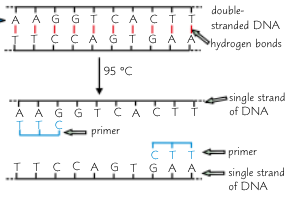
What are the 4th and 5th stages of PCR?
The reaction mixture is heated to 72°C so DNA polymerase can work (DNA polymerase is taq DNA polymerase = come form bacteria so can work at high temps)
DNA polymerase lines up free DNA nucleotides alongside each template strand. Complementary base pairing means new complementary strands formed
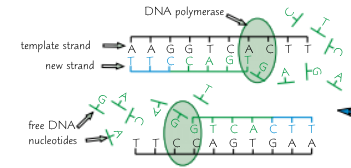

What are the 6th,7th (last) stages of PCR?
2 new copies of the fragment of DNA are formed and one cycle of PCR is complete
The cycle starts again with the mixture being heated to 95°C and this time all 4 strands (2 og and 2 new) are used as templates

What does each PCR cycle do the volume of DNA?
double it
first cycle = 2×2 = 4 dna fragments
2nd cycle = 4 × 2 = 8 dna fragments
3rd cycle = 8 × 2 = 16 dna fragments
Why do you add a flourescent tag to the DNA that has just done PCR in DNA profiling?
So that all the DNA fragments can be viewed under UV light
What is gel electrophoresis used to do?
Separate out the DNA fragments
How does gel electrophoresis work?
DNA placed into well in slab of gel + covered in buffer solution that conducts electricity
electrical current passed through gel - DNA fragments negatively charged so they move towards anode (positive electrode) at far end of gel
Short DNA fragments move faster and travel further through gel, so DNA fragments separate according to length
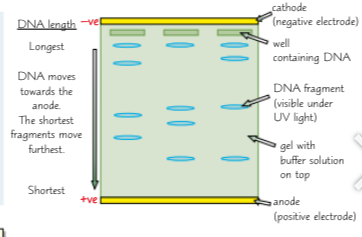
What is the DNA profile
The DNA fragments appear as bands under UV light
How is UV light used to compare DNA?
DNA fragments from gel electrophoresis appear as bands under UV light - DNA profile
2 DNA profiles can be compared to see how similar pattern of bands on gel is - a match could help identify a person, or determine a genetic relationship
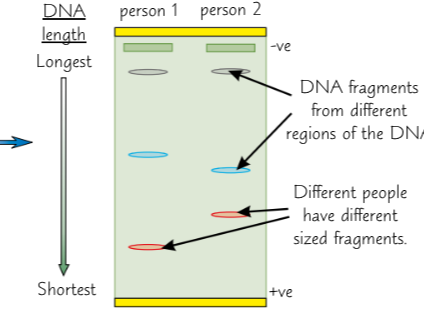
How can DNA profiling be used to identify people in forensic science
DNA isolated from all collected samples (from crime scene + suspects)
Each sample amplified using PCR
PCR products are run on electrophoresis gel and DNA profiles produced are compared to see if any match
If samples match, links person to the crime scene
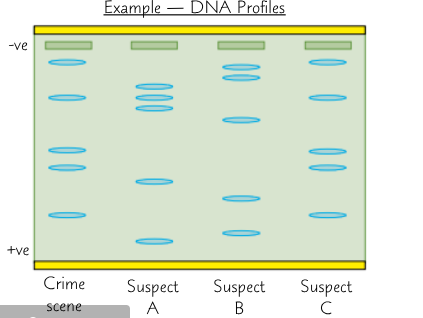
How can DNA profiling be used to determine the genetic relationship in humans?
DNA inherited from parents
= more bands one 2 DNA profiles that match = more closely related (genetically similar) the two people are
e.g. paternity tests used to determine biological father of child by comparing DNA profiles. If lots of bands match then person is most probably the father
Why is DNA profiling used in animals and plants and why is it important?
to prevent inbreeding (which causes health, productivity and reproductive problems + decreases the gene pool = increase risk of genetic disorders = health problems)
Can be used to identify how closely related individuals are - the more closely related 2 individuals are, the more similar their DNA profiles will be. The least related individuals will be bred together
What is electrophoresis commonly performed on?
agarose gel that has been poured into a gel tray and left to solidify
a row of wells is created at one end of the gel
Once you have the gel how should electrophoresis be performed?
Put the gel into a gel box and made sure the end of the gel tray with wells is closest to the negative electrode (cathode) on the gel box
Then add buffer solution to the reservoirs at the sides of the gel box so that the surface of the gel becomes covered in the buffer solution
What are the steps of gel electrophoresis?
Add the gel tray to a gel box
Load DNA samples into the wells
Carry out electrophoresis
How do you load the DNA samples into the wells? - the process
take your fragmented DNA samples and using a micropippette add the same volume of loading dye to each
Then add a set volume of a DNA sample to the first well
repeat, adding the same volume and using a clean micropippette tip each time
record which DNA sample added to each well
Why is loading dye added to DNA fragments in gel electrophoresis?
To help the samples sink to the bottom of the wells and make them easier to see
What should you do to be careful when adding DNA to the gel in electrophoresis?
Make sure the tip of the micropippette is in the buffer solution and just above the opening of the well. Don’t stick the tip of the micropippette too far into the well or you could pierce the bottom of it
How Is the actual gel electrophoresis carried out?
put lid on gel box + connect the leads from gel box to power supply
Turn on power supply and set it to required voltage = electrical current passes through gel
Let gel run for about 30 mins then turn off power supply
remove gel tray from gel box and tip off any excess buffer solution
wearing gloves stain the DNA fragments by covering surface of gel with a staining solution then rinsing gel with water.
Bands of different DNA would be visible
